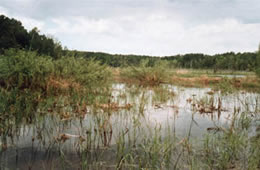|
|
 |
 |
| |
Kummer Sanitary Landfill Restoration in Minnesota. Levelers were installed to inundate and thus create 40 acres of wetland habitat to replace waterfowl, wading birds & neotropical migrants habitat lost at the landfill site. Credit:USFWS.
|
The Restoration Program
When hazardous substances
enter the environment, fish, wildlife, and other natural resources
can be injured. The U.S. Fish and Wildlife Service, along with
other Department of Interior, State, Tribal and Federal partners,
act as "trustees" for these resources. The U.S. Fish
and Wildlife Service has responsibility for National
Wildlife Refuges, endangered
and threatened species, migratory
birds, and other natural resources. Trustees seek to identify the natural resources injured, determine the extent of the injuries, recover damages from those responsible, and plan and carry out natural resource restoration activities. These efforts are possible
under the Natural Resource Damage Assessment and Restoration
Program (Restoration Program), the goal of which is to restore
natural resources injured by contamination. More
info. (1.6MB pdf).
Restoring the Resources To
fulfill the mission of restoring natural resources that have been
injured by oil spills or hazardous substance releases, several
steps must be taken. First, the natural resource trustees conduct
a damage assessment to determine the extent of injury to natural
resources caused by the hazardous substance release. This information
is used to determine the amount of restoration that is needed.
The trustees then negotiate a settlement with the responsible parties
for the cost of restoration, loss of use of the land or natural
resources by the general public, and money spent to assess damages.
Once a settlement has been reached, the trustees take action to
restore the injured resources. Finally, the trustees monitor the
completed restoration projects to ensure success. Benefiting
the Fish, Wildlife and the Public The primary benefit of the
Restoration Program is that injured natural resources can be restored at
no cost to taxpayers. Instead, the responsible parties
pay for the restoration. In addition, because of this Program,
people across the country are enjoying rivers and lands that are
once again healthy and teeming with fish and wildlife, and public
places that are safe for recreation and other uses.
Recent Restoration Activities:
Virginia, Powell River
|
On October 24, 1996, a failure in a coal slurry impoundment associated with a coal processing plant owned by Lone Mountain Processing, Inc. (LMPI) in Lee County, Virginia, resulted in the release of six million gallons of coal slurry to the Powell River watershed. “Blackwater,” a mix of water, coal fines, clay, and associated contaminants, extended more than twenty miles downstream. The coal slurry spill impacted fish, endangered freshwater mussels, other stream organisms, supporting aquatic habitat, and designated critical habitat for three federally endangered mussels and two federally endangered fish.
A Restoration Plan was completed in June 2003. The Plan focused on Riparian habitat protection and
enhancement, and propagation (breeding) of mussels in captivity and the release of these mussels once they reach an appropriate size. To date, thousands of hatchery-reared
juvenile mussels of 15 species have
been released in the Powell River
to restore populations, including
individuals of five federally-listed
endangered species. In addition, more than 800 hatchery-reared
yellowfin madtom have been released
to augment
the populations in the Powell River.
Fact Sheet on the Powell River spill and restoration plan (December, 2010. pdf)
Learn about freshwater mussels: Virginia Department of Game and Inland Fisheries - Freshwater mussels |
|
Virginia, Clinch River
|
On August 27, 1998, a tanker truck overturned on U.S. Route 460 in Tazewell County, Virginia. The truck released approximately 1,350 gallons of Octocure 554-revised, a rubber accelerant, into an unnamed tributary about 530 feet from its confluence with the Clinch River. The spill turned the river a snowy white color and caused significant fish and mussel kills. Prior to the chemical spill, this area in the Clinch River supported very diverse populations of mussels, including three federally listed endangered species.
Mussels are important because they stabilize river and stream bottoms. They also act as natural filters by straining out suspended particles from the water as they feed. In addition, mussels are a vital link
in riverine food webs, serving as prey for wildlife such as the muskrat, otter, raccoon, mink, and
fish. Young mussels are also eaten by sport fish and waterfowl. For this reason, the primary focus of the Restoration Plan that was developed was on freshwater mussels. The Restoration Plan includes propagation (breeding) of mussels in captivity and the release of these mussels once they reach an appropriate size. A public event was recently held for the release of propagated mussels into the Clinch River.
Video of the Mussel Release
Final Restoration plan (pdf)
Virginia Department of Game and Inland Fisheries - Freshwater Mussel Restoration: Clinch River
Virginia Tech - Freshwater Mollusk Conservation Center |
|
Links:
Deepwater Horizon Damage Assessment and Restoration
Restoration Plans on the Web
Fact Sheets
Frequently Asked Questions
Fish and Wildlife Service Regional Restoration Web Sites:
Region 2 - Southwest Region (Arizona, New Mexico, Oklahoma, and Texas) Restoration Website
Region
3 - Great Lakes/Big Rivers (Illinois,
Indiana, Iowa, Michigan, Missouri, Minnesota, Ohio and Wisconsin) Natural
Resource Damage Assessments web site
Region 4 - Southeast Region (Alabama, Arkansas, Florida, Georgia, Kentucky, Louisiana, Mississippi, North Carolina, Puerto Rico and Virgin Islands, South Carolina, Tennessee) Contaminants Site
Region
5 - Northeast Region (Connecticut,
Delaware, Maine, Maryland, Massachusetts, New Hampshire,
New York, New Jersey, Pennsylvania, Rhode Island, Vermont,
Virginia, West Virginia)
Region
6 - Mountain/Prairie Region (Colorado,
Kansas, Montana, Nebraska, North Dakota, South Dakota, Utah,
Wyoming) Restoration web site
U.S.
Department of Interior, Natural Resource Damage Assessment
and Restoration Program
|
|
